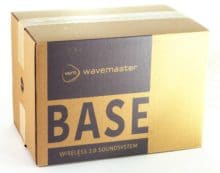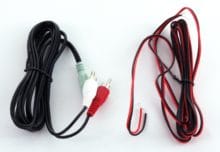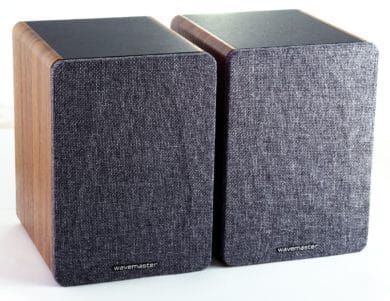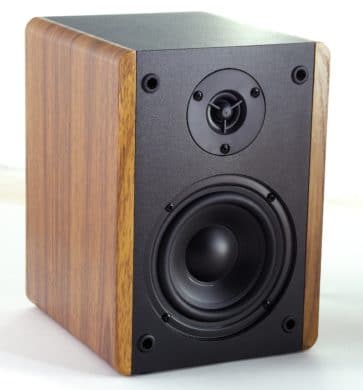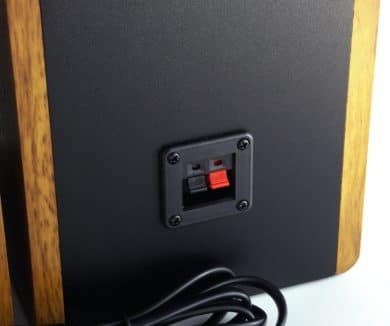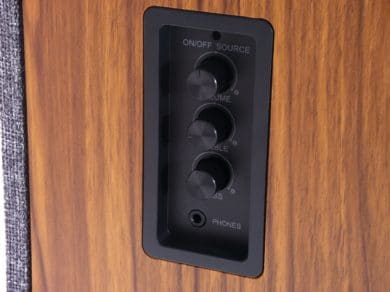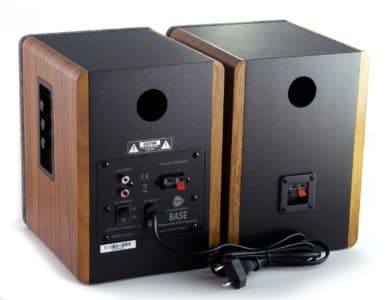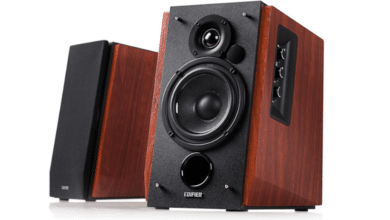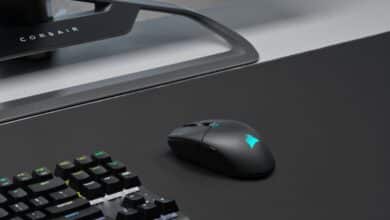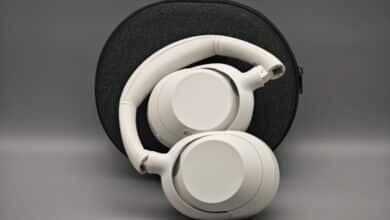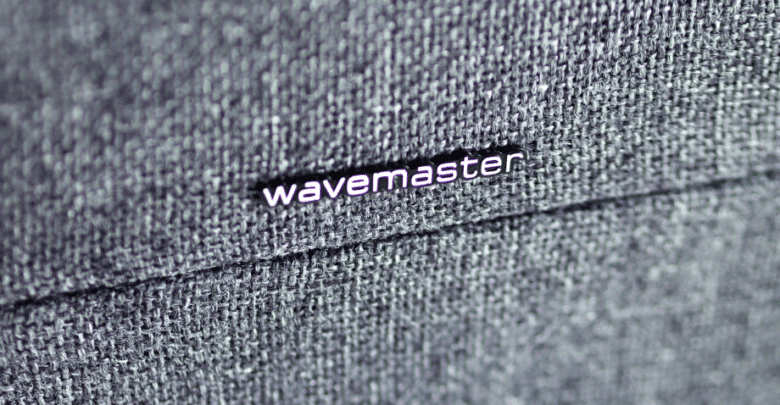
Wavemaster’s 2.0 loudspeaker system, simply called “Base”, is a small loudspeaker system which, despite its moderate price of € 69.00 *, is supposed to offer good sound quality. The Wavemaster Base certainly does justice to its designation as a “shelf loudspeaker”, as there is plenty of room for the small speakers in many shelves. What it looks like in terms of workmanship, functionality and sound quality is shown in the following test.
Specifications
| Dimensions per box: | 160 x 220 x 185 mm |
| Design type: | 2.0 Stereo |
| Frequency range: | 50 Hz – 22 kHz |
| Output power: | R/L: 15 W + 15 W |
| Chassis: | Tweeter: 1 inch (25 mm), Mylar woofer: 4.5 inch (115 mm), cellulose cone |
| Inputs: | Cinch, Bluetooth |
| Outputs: | 3.5 mm jack (headphones) |
| Cable: | connecting cable loudspeaker: 2,5m Cinch cable: 1.5m |
| Price: | € 69.00 * |
Design and Workmanship
Wavemaster’s base loudspeakers tend to be retro-orientated. This is due in particular to the fabric covering, which is coarse and woven with slight colour variations. For the body, the company relies on a standard MDF sound body with a wood look on the sides.
However, this is not achieved by veneering, but – as is often the case today – by a plastic surface that creates a deceptively realistic reproduction of real wood. The rest of the body is completely in matt black. Whether you like this combination is, as always, left to your own taste. At least in our eyes, the combination of coarse fabric, wood and black accents is a success.
The processing quality of the Base is up to date: The gap transitions are not quite exact on closer inspection, but this is not to be expected in this price range either. Optically and haptically, the loudspeakers are therefore impeccable almost everywhere, only at the back of the main loudspeaker there is something to complain about: The metal terminal on our model had a few fine scratches.
Features and Connections
The Wavemaster Base uses a combination of tweeter and woofer and can be connected either via Bluetooth or a pair of Cinch plugs. All connections and adjustment options are located on the right speaker. The position can of course be changed by swapping the Cinch connectors.
As usual, the loudspeaker connection terminal is located at the rear of the speakers. The auxiliary loudspeaker only has the two cable clamps for the audio signal installed, the master box, on the other hand, additionally offers the two RCA sockets, a power switch and the power cable. All this is mounted on the aforementioned black metal plate.
The three rotary knobs and a 3.5 mm jack socket are located on the right side of the speaker. This is a good compromise between the potentially annoying look when the controls are located at the front and the poor accessibility when they are located at the rear.
The jack socket serves as a headphone socket and is probably intended for use on a PC: if you place the speakers in such a way that the controls are easily accessible, you can simply connect headphones and don’t have to put another cable on your desk. If headphones are connected, the loudspeakers are deactivated and the sound is output via the connection.
The optional socket is therefore a nice extra that saves wiring work in some cases. However, the function is only perfect if the loudspeakers and headphones have comparable control characteristics. Since the volume is coupled to each other in both cases, you’ll always have to adjust it manually when you plug in and unplug your headphones.
The uppermost of the rotary knobs is a rotary encoder and therefore works digitally. It is used for changing the audio transmission mode (analogue ↔ Bluetooth) and for volume control. An analog volume control would of course have been more flexible, but this implementation is the common standard for Bluetooth loudspeakers.
Fortunately, the volume control is also finely resolved with the rotary encoder. The Base also has a short response time between turning the volume control and actually changing the volume.
The rotary knobs for the treble and the bass are designed as potentiometers and thus analog, and they adjust the crossover in the loudspeaker accordingly. Both offer a wide range, so that the sound can be adapted well to your own requirements.
Sound quality (analog)
As with all speakers, the sound characteristics of the Wavemaster Base depend heavily on its position in the room. The bass in particular can be influenced in this way, and this also plays an important role with the Base.
If these are positioned freely in the room, i.e. have no wall directly behind them, the bass is only weakly pronounced without changes to the corresponding knob. Unless one helps by hand, the sound lacks “fullness”. The situation is completely different if the speakers are set up “with their back to the wall”. Depending on the distance, the sound becomes ideal by itself, or you even have to turn the bass back a little so that it doesn’t start to boom.
If the speakers are set up and adjusted correctly, the base speakers offer a good sound image for the size and price. The sound is full, detailed and can also provide bass in a solid frame. However, you shouldn’t expect too much bass, as the loudspeakers will swallow more and more details – so if you want to shake up your own home, this is not the right place. The midrange and treble are on a solid level, but don’t set new standards.
The Wavemaster Base can fill a large room with sound without any problems and without distortion. However, the bass quickly runs out of air, so the Wavemaster Base is just an emergency solution for larger parties or the like. Wavemaster also has to put up with criticism for a slight background noise. This is very quiet and therefore only noticeable in absolute silence, but it should have been avoided.
Playback via Bluetooth
The main loudspeaker of the Wavemaster Base also serves as a Bluetooth receiver. Switching between analogue and Bluetooth transmission is done by pressing the rotary encoder. As usual, an LED indicates the current status: Green for analogue, blue for Bluetooth and red for standby mode.
As soon as the speakers are in Bluetooth mode, they can be found as usual via all Bluetooth playback devices. They are called “wm BASE” in the menu. Once the pairing is complete, the sound is transmitted as expected. The range is the same as that of Bluetooth: even if the playback device is located some distance away or in the adjoining room, for example, uninterrupted playback is possible.
The integrated digital-to-analog converter used for Bluetooth playback provides a decent but not impressive truth. In comparison to our FiiO E10K Olympus 2 used for the analog tests, some details are lost, even though this can be justified in view of the price difference. Nevertheless, we would prefer playback via a well implemented onboard sound chip. The Bluetooth mode is therefore more for background music than for active listening.
Fulness
Wavemasters Base Speakers are a solid total package in every respect. They offer outstanding performance at no point, but at an affordable price, they perform well in all areas.
Once the bass control is adjusted to match the position of the speakers, the speakers deliver a full sound that can be used for affordable music enjoyment. However, the small size of the speakers cannot be concealed by the sound: If you want a particularly strong bass, you’re not in the right place here because you don’t have a subwoofer.
For use at the desk, we like the way the control knobs are accommodated: the lateral positioning is still easy to reach and leaves the front of the individual speakers untouched. The headphone connection is also likely to find some friends: If you use an external microphone or no microphone at all, the connector saves an additional cable.
Unfortunately, Wavemaster’s new speakers are also struggling with a well-known problem with Bluetooth speakers: using a rotary encoder instead of a potentiometer to adjust the volume would not be a major problem, but the latency between setting and actual change is and remains too high. The base is among the faster representatives, but the solution isn’t really intuitive yet.
Last but not least, there is one point that loudspeakers should not neglect: the optics. Here Wavemaster delivers what we consider to be a perfectly harmonious package. Of course the demands on the design are individually different, but at least in our eyes the coarsely woven fabric leads to a special, appealing look. In any case, this is a more elegant solution than the all too popular piano lacquer elements.
The bottom line is that the Wavemaster Base is a good choice if you like its design and functionality. In the targeted price range of around 70 euros, the loudspeakers offer a sound that can compete well with models without optional Bluetooth support.
Wavemaster Base
Workmanship
Features
Sound
Value for Money
Small loudspeakers with solid sound and special optics
